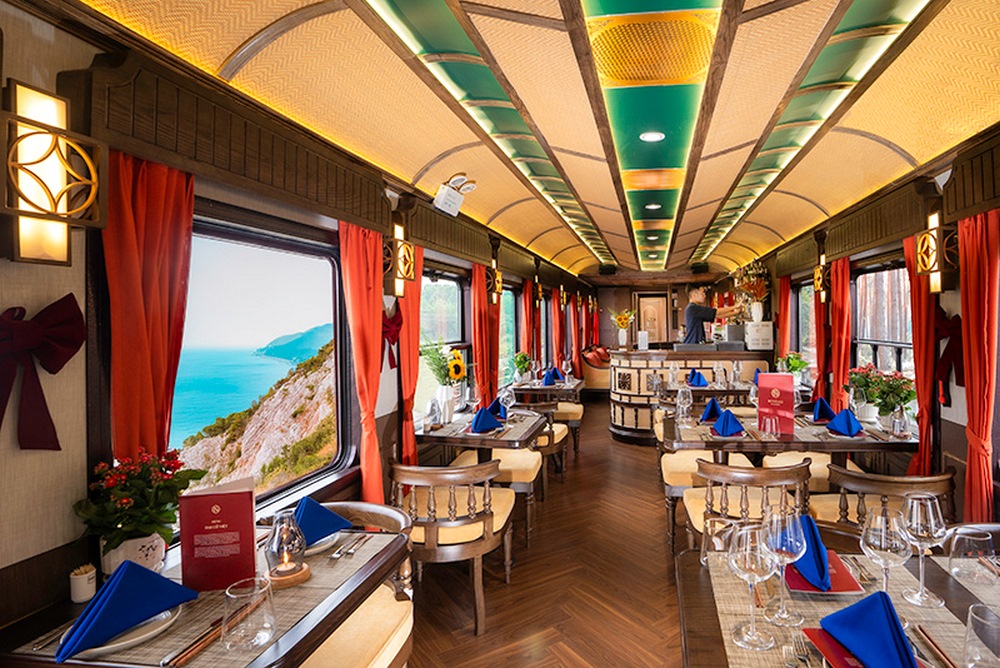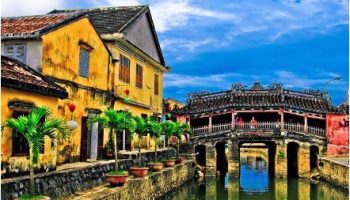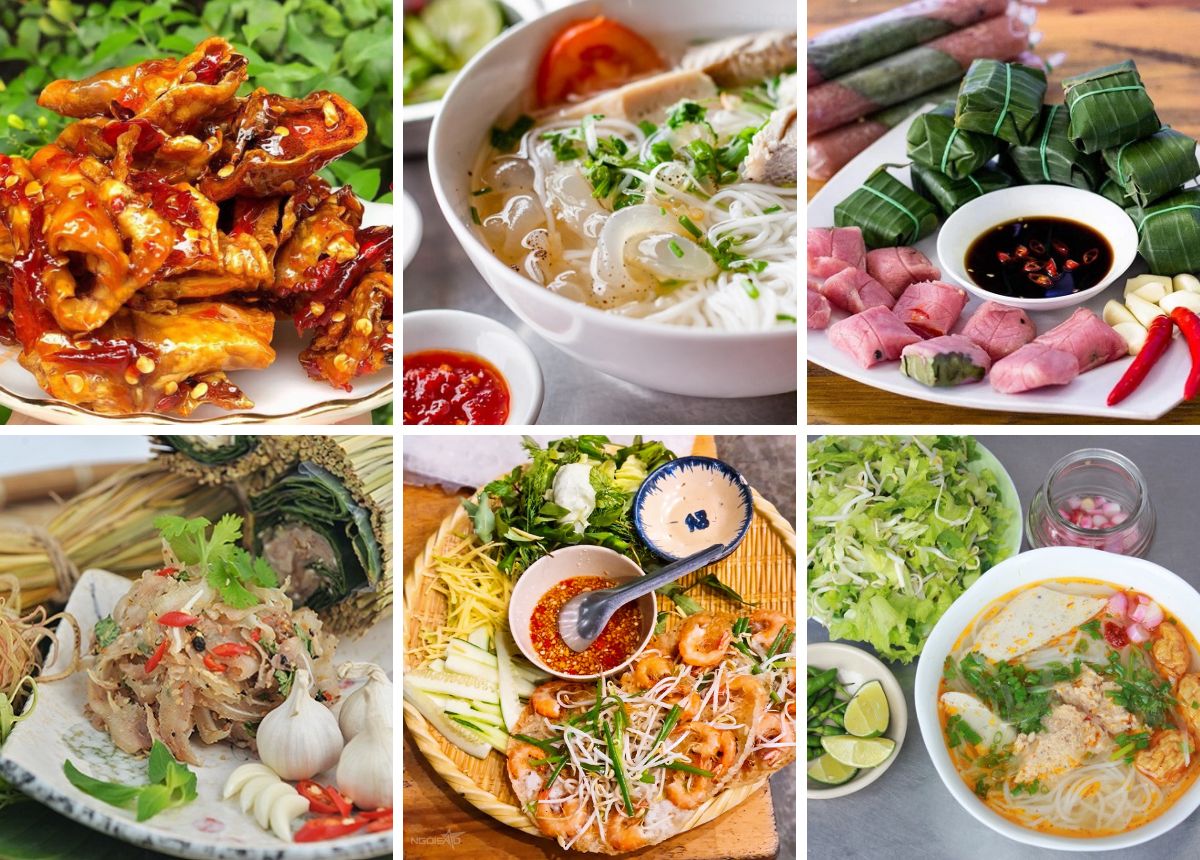
The Essence of Central Vietnamese Cuisine: A Culinary Journey
Central Vietnam is the land of culinary wonders, with dishes that illuminate the region’s rich history, diverse culture, and people’s lifestyle. Most popular for its balance of bold and intricate flavors, Central Vietnam cuisine displays its own characteristics in an irresistible way. From vibrant street food dishes to the regal experience of Hue Imperial City, every meal is a wonderful culinary journey.
Table of Contents
ToggleThe Essence of Central Vietnamese Cuisine

A true testament to this region’s creativity and resourcefulness lies in its bold and harmonious flavors. There are hints of spicy, salty, sweet, and sour elements that perfectly blend to make the dish itself a wonder. In addition, using only fresh ingredients and cooking hot on the go are two essential aspects that make it so enjoyable.
Notable ingredients are fresh herbs, fish sauce, chili, shrimp paste, and rice. Especially chili, an important element that is used more prominently than in the northern and southern regions, truly giving many dishes their distinctive kick.
Central Vietnam’s proximity to the coast means easy access to seafood. You can see various dishes including succulent prawns to tender squid, making the whole culinary journey satisfactory. The inspiration for each dish also stems from the royal culinary traditions, particularly in Hue, where the royal created their signature and nutritious meals. That said, making every bit a story of cultural pride and historical richness.
Read more: Vietnamese Cuisine: The Differences in Cuisine Across the Three Regions North – Central – South
Must-Try Central Vietnamese Cuisine
1. Bún Bò Huế
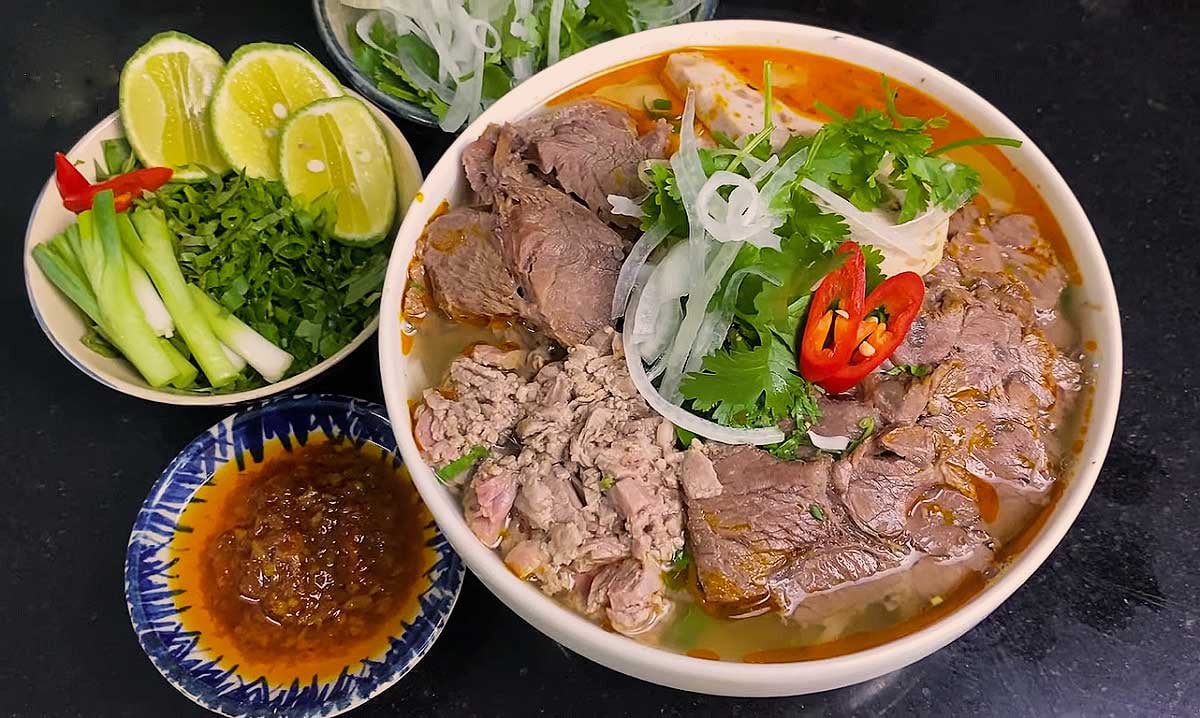 If Hanoi is most known for Pho, then Bun Bo Hue is the soul of Central Vietnamese cuisine. It is a hearty and savory noodle soup dish that features beef and pork parts like pork knuckles or pig blood curds and thick noodles. The fun of this dish is that you can actually choose the topping from either a special bowl with all of the elements or just simply choose beef for a light soup bowl.
If Hanoi is most known for Pho, then Bun Bo Hue is the soul of Central Vietnamese cuisine. It is a hearty and savory noodle soup dish that features beef and pork parts like pork knuckles or pig blood curds and thick noodles. The fun of this dish is that you can actually choose the topping from either a special bowl with all of the elements or just simply choose beef for a light soup bowl.
Its broth is a key aspect that brings all the elements together, just an added squeeze of lemon, the whole dish is enriched with lemongrass, chili, and shrimp paste, creating an unforgettable taste. On the side, enjoy it with banana blossoms and fresh herbs for its completion of a balanced soup meal.
2. Cao Lầu
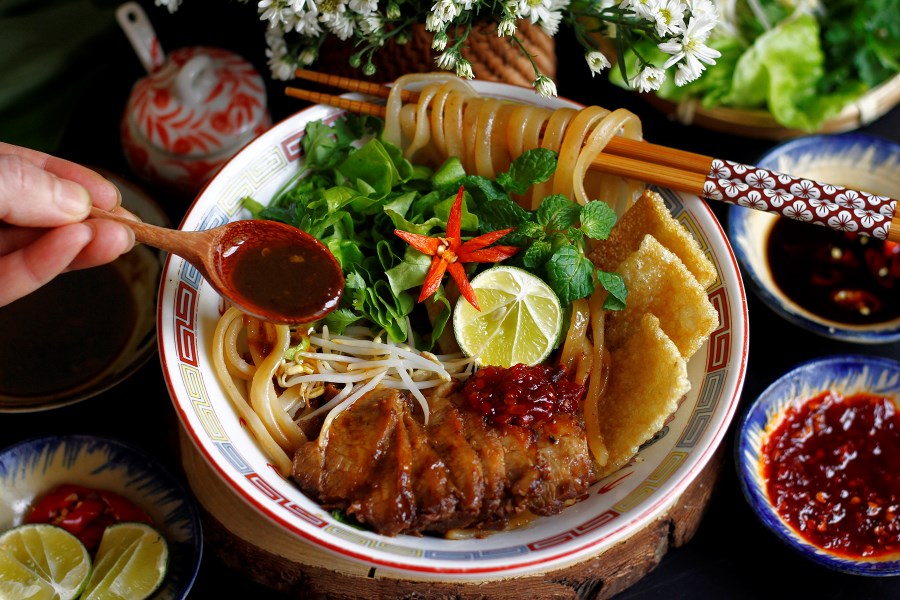 Arriving in Hoi An Ancient Town in Danang, you are invited to a signature noodle dish that combines chewy noodles, tender pork, fresh greens, and a flavorful broth known as Cao Lau. Back in the 16th and 17th centuries, merchants from China, Japan, and other parts of Asia brought with them not only goods but also culinary preferences. This is why Cao Lau is believed to have been inspired by the soba noodles of Japan and the Chinese influence seen in its preparation.
Arriving in Hoi An Ancient Town in Danang, you are invited to a signature noodle dish that combines chewy noodles, tender pork, fresh greens, and a flavorful broth known as Cao Lau. Back in the 16th and 17th centuries, merchants from China, Japan, and other parts of Asia brought with them not only goods but also culinary preferences. This is why Cao Lau is believed to have been inspired by the soba noodles of Japan and the Chinese influence seen in its preparation.
But what added to the interesting part of the dish is that the noodle soup is made using water from an ancient well in Hoi An, adding a unique flavor that is hard to replicate elsewhere.
3. Mì Quảng
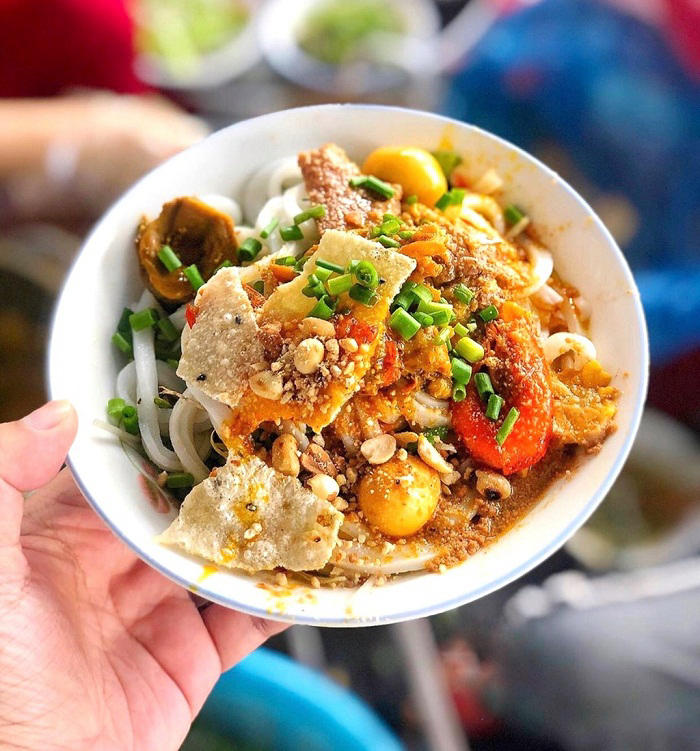 This Central Vietnamese cuisine, Mi Quang, directly reflects its origins where “Mi” means noodles, and “Quang” refers to Quang Nam province. In the past, this dish was considered for special occasions only because of its effort in preparation. Over time, it became a staple meal for everyday enjoyment and a comfort meal for many locals. It is all thanks to the vibrant noodle that combines light soup, shrimp, pork, peanuts, fresh herbs, and even crunchy rice crackers, making it a wholesome and filling dish.
This Central Vietnamese cuisine, Mi Quang, directly reflects its origins where “Mi” means noodles, and “Quang” refers to Quang Nam province. In the past, this dish was considered for special occasions only because of its effort in preparation. Over time, it became a staple meal for everyday enjoyment and a comfort meal for many locals. It is all thanks to the vibrant noodle that combines light soup, shrimp, pork, peanuts, fresh herbs, and even crunchy rice crackers, making it a wholesome and filling dish.
What’s more about this dish is that it can be versatile in terms of toppings. You can change from regular shrimp, and pork and go for a different meat-based like frog, fish, or vegetarian options. These are modern adaptations that demonstrate how Mi Quang continues to evolve while staying elegant to its roots.
4. Bánh Xèo
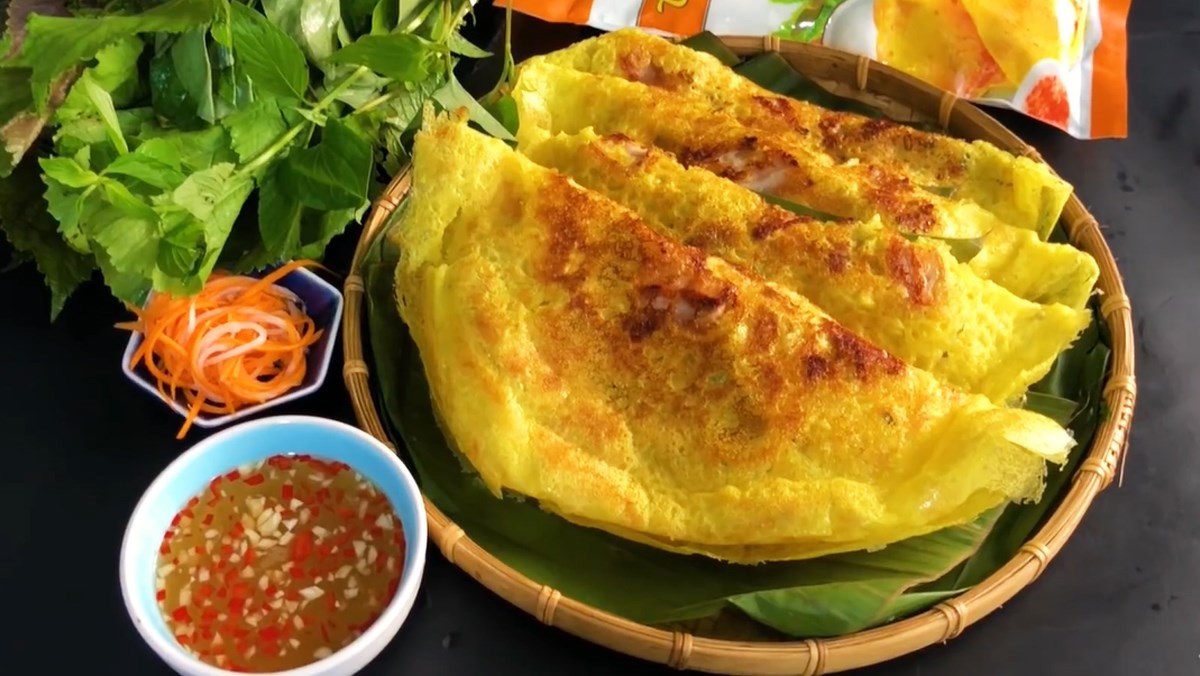 Banh Xeo is Vietnam’s beloved sizzling pancake. It is a savory delight that charms every hungry soul with its golden, crispy batter filled with a combination of pork, shrimp, and bean sprouts. Banh Xeo embodies the Central people’s personality that is fun, charming, smart adaptability. It is believed that during the French colonial period, local cooks learned about the French crêpe and innovated into what it is today.
Banh Xeo is Vietnam’s beloved sizzling pancake. It is a savory delight that charms every hungry soul with its golden, crispy batter filled with a combination of pork, shrimp, and bean sprouts. Banh Xeo embodies the Central people’s personality that is fun, charming, smart adaptability. It is believed that during the French colonial period, local cooks learned about the French crêpe and innovated into what it is today.
Banh Xeo evolved differently across Vietnam with each region displaying distinct fixtures. For example, Central Vietnam’s version of Banh Xeo is smaller, thinner, and crispier, making it easier to enjoy at any time during the day. Whereas the Southern region is the opposite, larger and the use of coconut milk in the batter is more popular.
5. Nem Lụi
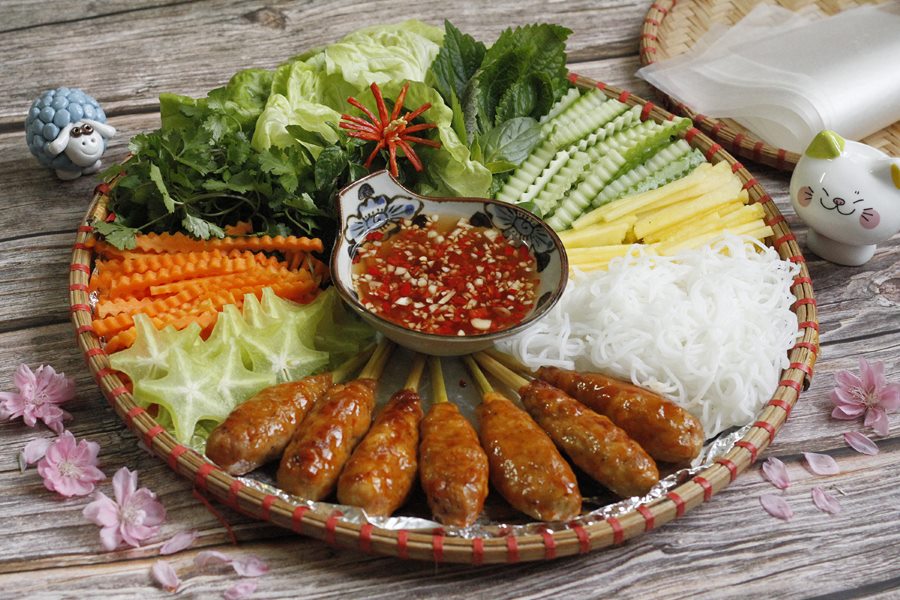 Nem Lụi originated in Hue, the former imperial capital of Vietnam. It remained an exclusive dish for the royal family for its unique preparations but through time, the dish found its way to the homes of commoners and it is celebrated to this day. The word “Nem” refers to meat preparations, typically made with ground pork, while “Lui” describes the act of threading the meat onto lemongrass stalks or bamboo skewers for grilling.
Nem Lụi originated in Hue, the former imperial capital of Vietnam. It remained an exclusive dish for the royal family for its unique preparations but through time, the dish found its way to the homes of commoners and it is celebrated to this day. The word “Nem” refers to meat preparations, typically made with ground pork, while “Lui” describes the act of threading the meat onto lemongrass stalks or bamboo skewers for grilling.
The unique aspect of Nem Lụi is how it’s eaten. People wrap the grilled meat with rice paper and pick vegetables like basil, mint, perilla, pineapple,… rather than eating the skewers directly. Then it is dipped into a rich and nutty sauce made of fermented soybeans, peanuts, and sesame seeds for that harmonious but explosive taste and texture.
6. Royal Cuisine of Hue
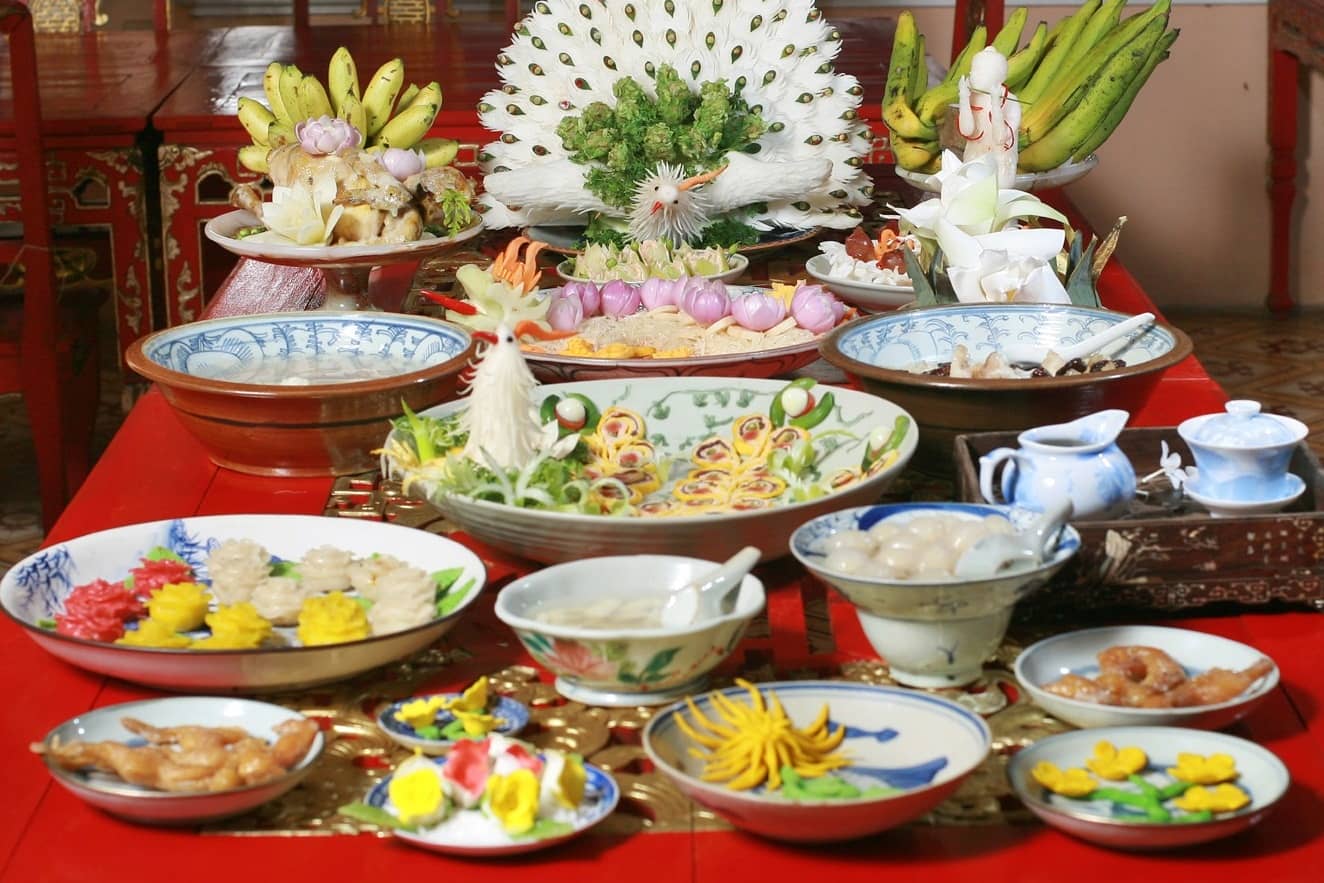 Part of Central Vietnamese cuisine is its elegant royal cuisine of Hue. Each culinary dish emphasizes elegance and artistry, formed altogether through its meticulous preparation and added artistic flair, reflecting the sophistication of past dynasties. Notable royal dishes include:
Part of Central Vietnamese cuisine is its elegant royal cuisine of Hue. Each culinary dish emphasizes elegance and artistry, formed altogether through its meticulous preparation and added artistic flair, reflecting the sophistication of past dynasties. Notable royal dishes include:
- Nem Rán Cung Đình: Imperial spring rolls, served with aromatic fish sauce to illustrate a delicate balance of flavors and intricate presentation, mirroring the grandeur of the imperial period.
- Chè Cung Đình: Royal sweet dessert soup that includes ingredients like lotus seeds and longan fruit, symbolizing health and prosperity.
- Bánh Bành (Imperial Cakes): A variety of intricately shaped sweet and savory cakes, often enjoyed during festivals and special occasions.
Central Vietnamese Hidden Gems and Local Specialties
The exciting part of a culinary journey is that Central Vietnam offers lesser-known food wonders, beyond the famous dishes. These are dishes that are cherished among locals and are allured in every nook and cranny of the street markets, humble roadside stalls, and tucked-away eateries. While they may not always be on the radar, they offer an authentic and in-depth taste of the region’s personality. Here are some interesting dishes to try:
Bánh Căn
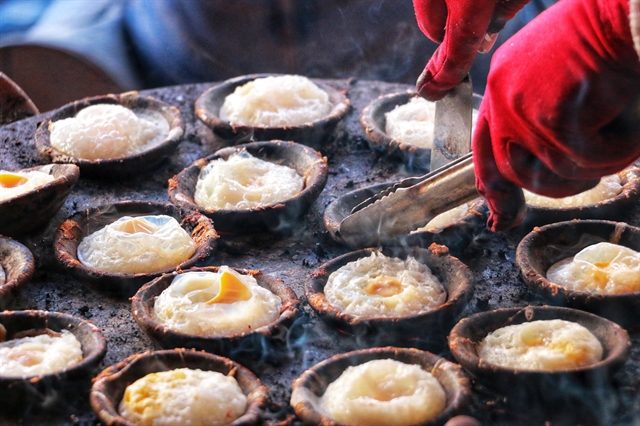 A profound and cute dessert dish made from flour batter poured into small terracotta molds. This bite-sized dish is typically cooked over hot coals and topped with a variety of ingredients like minced shrimp, pork, or quail eggs. The dish is then enjoyed with a tangy dipping sauce with a side of fresh herbs.
A profound and cute dessert dish made from flour batter poured into small terracotta molds. This bite-sized dish is typically cooked over hot coals and topped with a variety of ingredients like minced shrimp, pork, or quail eggs. The dish is then enjoyed with a tangy dipping sauce with a side of fresh herbs.
Where to eat: Bánh Căn An Hòa (22 Nguyễn Thiện Kế, Danang), Bánh Căn Hội An (53 Trần Hưng Đạo, Hội An), Bánh Căn Cô Mười (146 Ngô Mây, Quy Nhon)
Bánh It Lá Gai
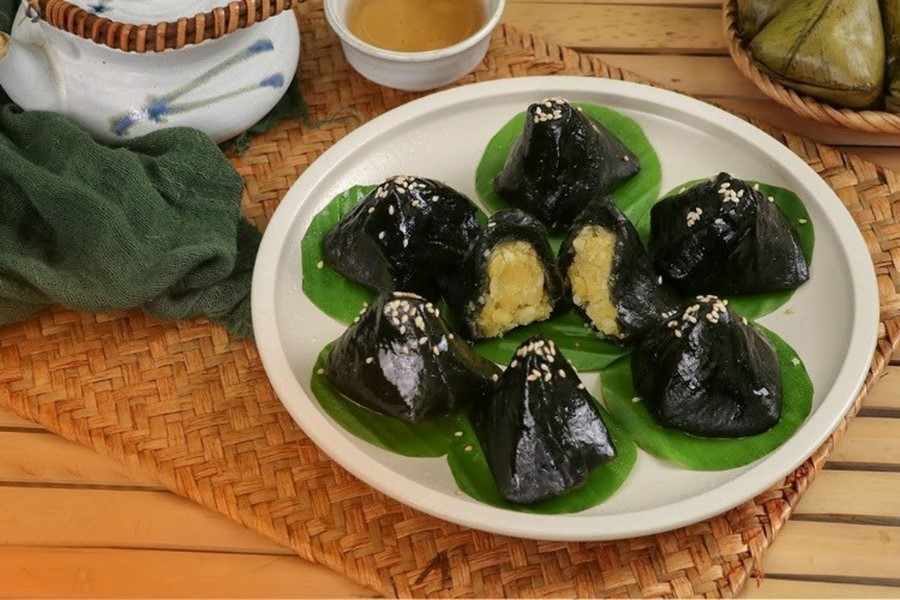 This is a Central Vietnamese cuisine that is a sweet and sticky dessert that originated from Quang Nam province, made of glutinous rice flour and black-covered leaves. Take a bite of it and you discover a wonderful flavor mix of mung beans, coconut, and sugar. Wrapped in banana leaves as the outer layer, Banh It La Gai is a treat that takes you to a different and authentic culinary experience.
This is a Central Vietnamese cuisine that is a sweet and sticky dessert that originated from Quang Nam province, made of glutinous rice flour and black-covered leaves. Take a bite of it and you discover a wonderful flavor mix of mung beans, coconut, and sugar. Wrapped in banana leaves as the outer layer, Banh It La Gai is a treat that takes you to a different and authentic culinary experience.
Where to eat: Bánh Ít Lá Gai Tuyết Mai (75 Nguyễn Huệ, Quảng Ngãi), Bánh Ít Lá Gai Lê Thị (15 Lê Duẩn, Da Nang), Bánh Ít Lá Gai Cô Hồng (12 Hoàng Hoa Thám, Da Nang)
Bún Hến
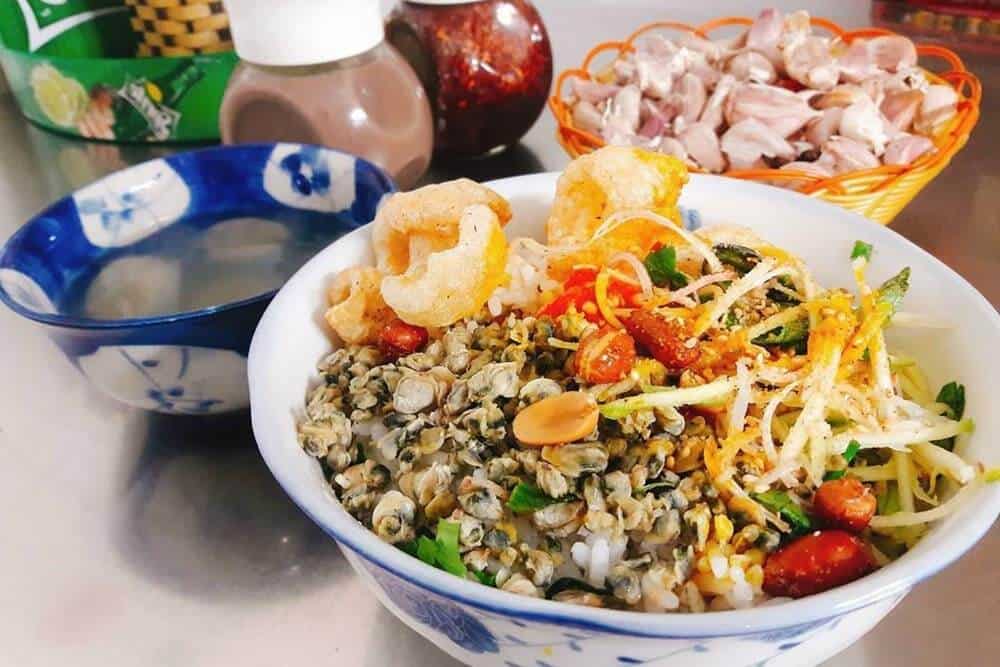 Traveling to Hue, it is a must to try Bun Hen – a noodle dish made with tender baby clams, crispy pork skin, peanuts, and a mix of fresh herbs. It is one of the most popular dishes among locals. Seafood is accessible in Central Vietnam so it is a dish that best represents the region’s resourcefulness. For an alternative experience, try Com Hen (baby clam rice), a similar dish with a different noodle/rice base.
Traveling to Hue, it is a must to try Bun Hen – a noodle dish made with tender baby clams, crispy pork skin, peanuts, and a mix of fresh herbs. It is one of the most popular dishes among locals. Seafood is accessible in Central Vietnam so it is a dish that best represents the region’s resourcefulness. For an alternative experience, try Com Hen (baby clam rice), a similar dish with a different noodle/rice base.
Where to eat: Bún Hến Cầu Vượt (106 Lê Duẩn, Da Nang), Bún Hến Ngọc Sương (39 Nguyễn Thị Minh Khai, Da Nang), Bún Hến Hội An (93 Nguyễn Thái Học, Hội An)
Mít Trộn
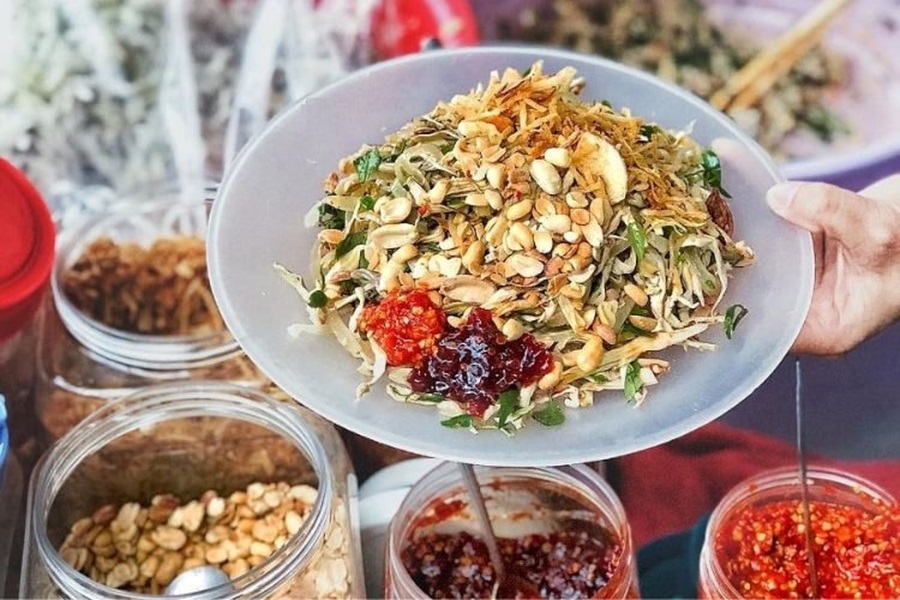 Features boiled young jackfruit mixed with shredded pork, shrimp, and fresh herbs, this is a signature and unique popular salad dish in Central Vietnamese cuisine. The ingredients are tossed in a tangy fish sauce dressing and then topped with roasted peanuts and crispy fried shallots, Mit Tron is a delightful and refreshing dish that illustrates the region’s creativity and focus on freshness.
Features boiled young jackfruit mixed with shredded pork, shrimp, and fresh herbs, this is a signature and unique popular salad dish in Central Vietnamese cuisine. The ingredients are tossed in a tangy fish sauce dressing and then topped with roasted peanuts and crispy fried shallots, Mit Tron is a delightful and refreshing dish that illustrates the region’s creativity and focus on freshness.
Where to eat: Mít Trộn Bà Mập (23 Lê Lợi, Hue), Mít Trộn Quảng Ngãi (21 Nguyễn Huệ, Quảng Ngãi),…
Where to Experience Central Vietnamese Cuisine
It is not hard to experience the rich and diverse flavors of Central Vietnamese cuisine as street food is so accessible throughout the region. There are countless opportunities to indulge in authentic dishes from bustling markets, and local food stalls to fancy restaurants.
Renowned Restaurants
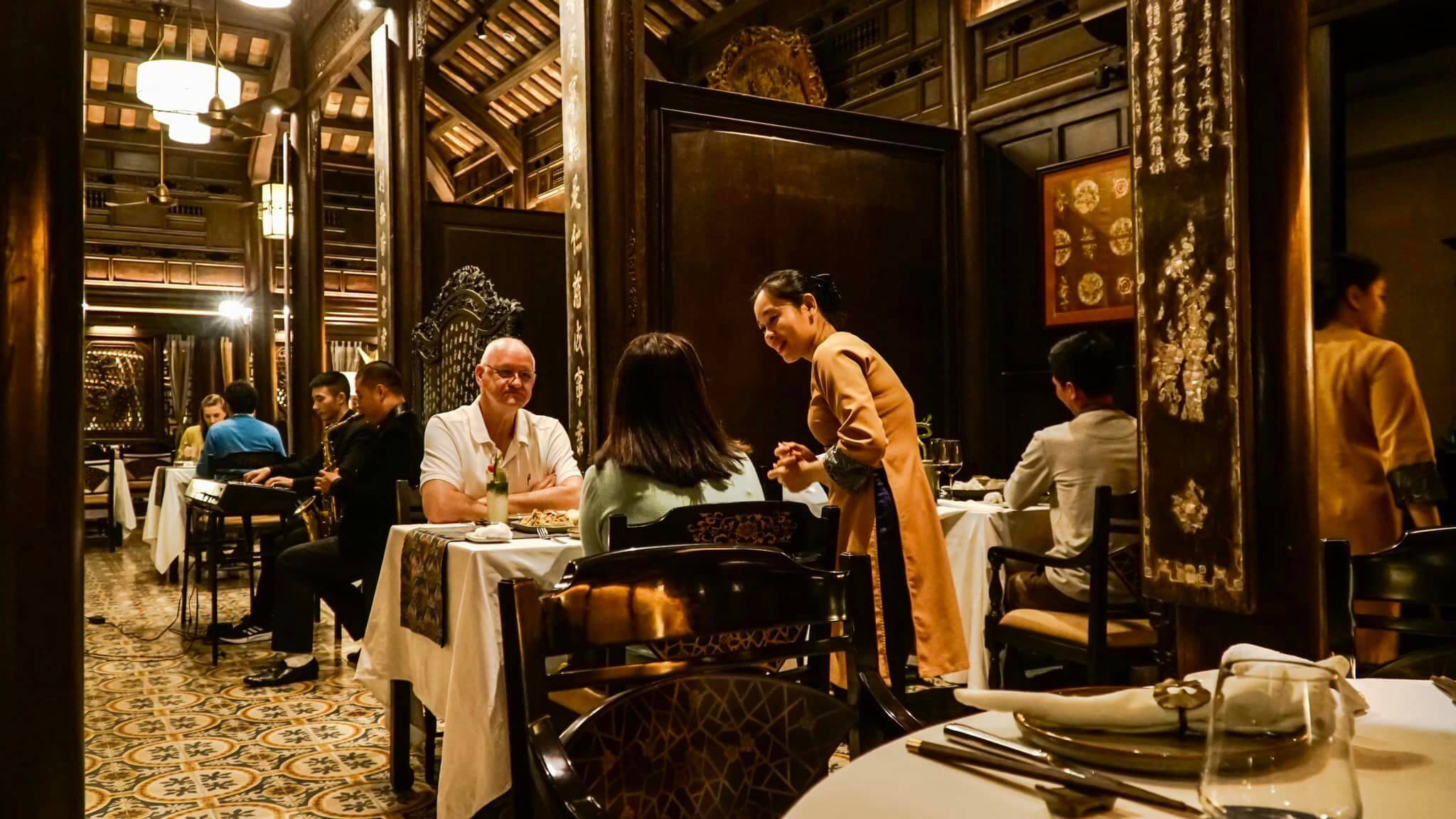 Sample traditional dishes at renowned eateries in Hue, Da Nang, and Hoi An. Highlights include “Ancient Hue” for royal cuisine, “Ba Le Well” for authentic Hoi An flavors, and “Madame Lan” in Da Nang for a mix of traditional and modern dishes.
Sample traditional dishes at renowned eateries in Hue, Da Nang, and Hoi An. Highlights include “Ancient Hue” for royal cuisine, “Ba Le Well” for authentic Hoi An flavors, and “Madame Lan” in Da Nang for a mix of traditional and modern dishes.
- Ancient Hue (Hue): The Ancient Hue offers a regal experience from its delicious meal accompanied by the imperial court ambiance. This restaurant illuminates lavish meals that were once served to Vietnamese emperors. It also includes an extensive menu featuring many traditional dishes.
- Ba Le Well (Hoi An): A local favorite in the ancient town of Hoi An, Ba Le Well offers traditional Hoi An flavors, most notably the famous Bánh Xèo and Cao Lầu. The meal is prepared using recipes passed down through generations, making it an essential stop for a true taste of Hoi An.
- Madame Lan (Da Nang): Madame Lan is infused with traditional Central Vietnamese dishes and modern culinary twists. Dishes like Mi Quang and Bánh Bèo are served in a contemporary environment, blending the old and new in one bite.
Traditional Markets
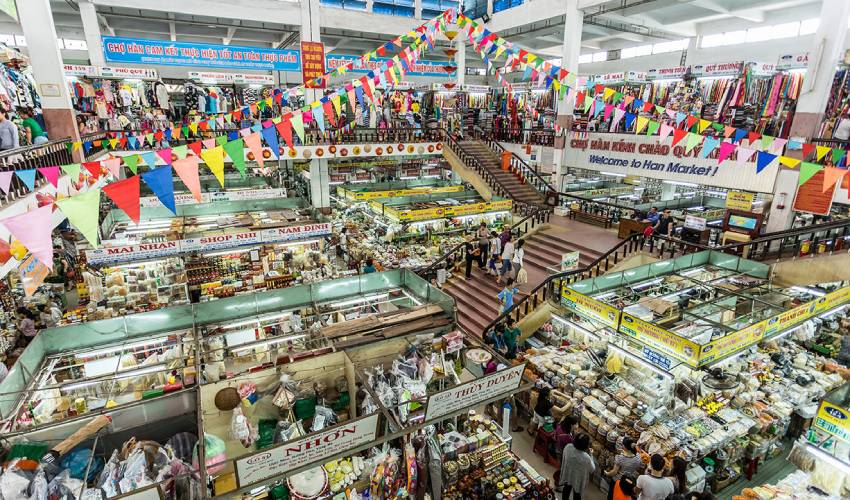 Traditional markets are the heart of Vietnam’s culinary culture, offering not just authentic and fresh tastes but also a window into local life. Two of the must-visit markets for Central Vietnamese cuisine are Dong Ba Market in Hue and Han Market in Da Nang.
Traditional markets are the heart of Vietnam’s culinary culture, offering not just authentic and fresh tastes but also a window into local life. Two of the must-visit markets for Central Vietnamese cuisine are Dong Ba Market in Hue and Han Market in Da Nang.
- Dong Ba Market (Hue): Located in the heart of Hue, Dong Ba Market is an iconic destination for food lovers. You can find pretty much everything in this market. The market is an explosive combination of sights, sounds, and smells with busy vendors offering cooked-to-order dishes.
- Han Market (Da Nang): Known for its lively atmosphere, Han Market in Da Nang offers an eclectic mix of street food and fresh produce. Explore different market stalls to sample local specialties and fill in any hunger desires.
Cooking Classes
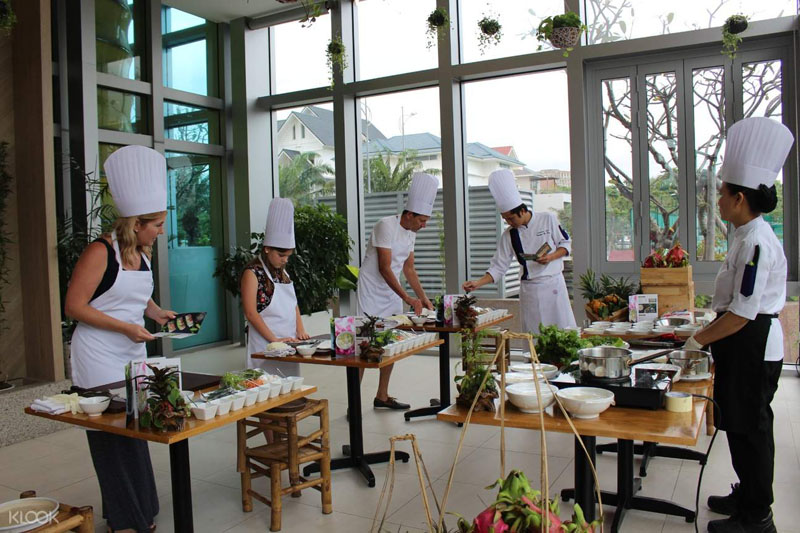 No better way to learn the depth of the dish than by making it. Consider hands-on cooking classes in Hoi An or Hue where you get to learn about the origin of the dish then make it yourself with local artisans and chefs.
No better way to learn the depth of the dish than by making it. Consider hands-on cooking classes in Hoi An or Hue where you get to learn about the origin of the dish then make it yourself with local artisans and chefs.
Usually, the classes are an integrated part of the tour where they take you to local markets before returning to the kitchen. You will then have the opportunity to make dishes like Banh Xeo.
- Integrated Executions: If you’re considering a tour through Central Vietnam, the SJourney train offers curated off-train itineraries, including cooking classes. With this experience, you get to experience the region in an educational way while traveling on the go at the same time, ensuring you make the most of your journey. Explore more of the itinerary here
Exciting Culinary Journey with Central Vietnamese Cuisine
The elegance and attention to balancing the flavors in Central Vietnamese cuisine have made it an irresistible food experience. Each bite of the dishes is a window into the region’s culinary heritage. Combined with the right itinerary and hands-on experience, it is an adventure of fulfillment and satisfaction. So, let’s set off on your own Central Vietnamese food adventure and savor every moment!
Read morre:
Central Vietnamese Cuisine: Must-Try Dishes & Hidden Gems





